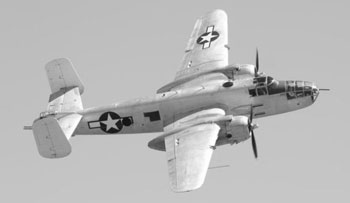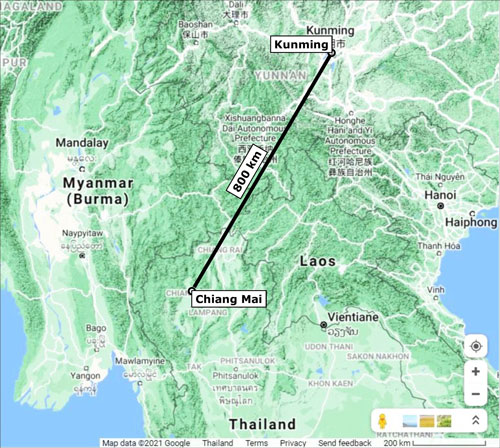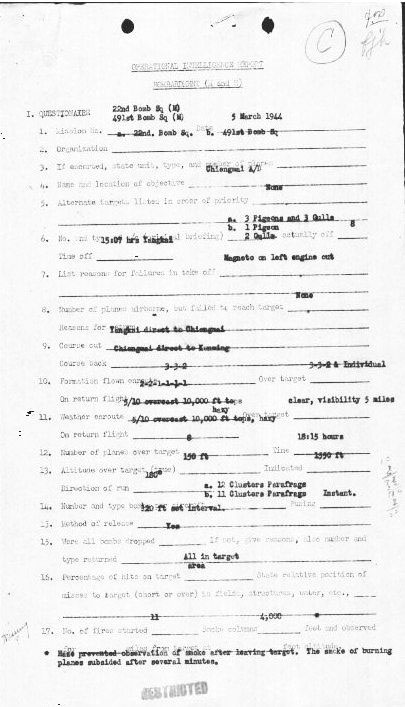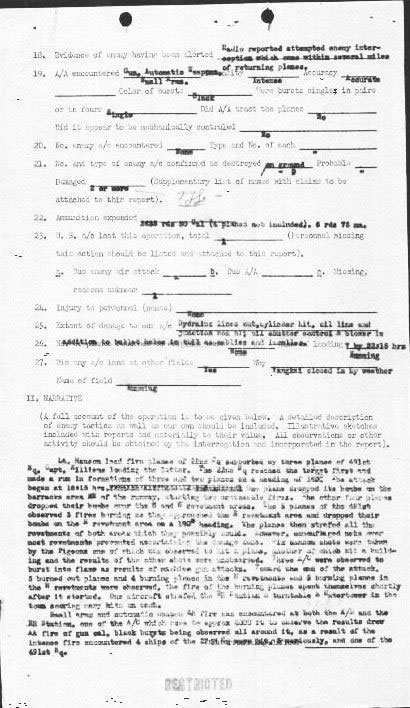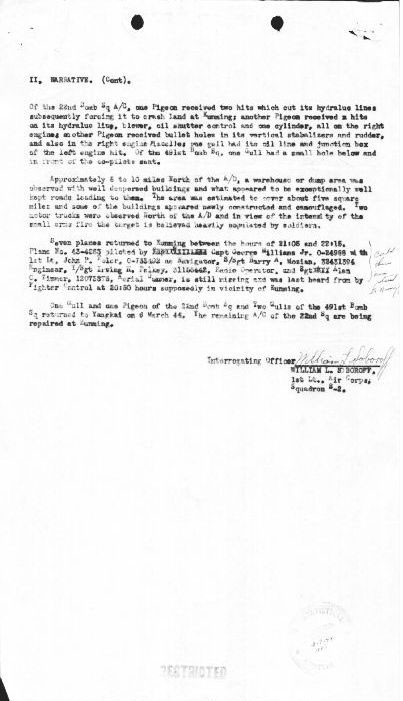| Details of Aircraft Losses by Date |
| Text | Notes | ||||||||||||
|
05 Mar 1944: Warned by Allied intelligence that preparations for an attack on 14th Air Force facilities (possibly Kunming) were in an advanced stage at the Japanese air base in Chiang Mai, Gen Claire Chennault ordered a preemptive air strike. The 22nd and 491st Bombardment Squadrons of the 341st Bombardment Group homebased at Yangkai Airport[a] with medium bombers, B-25Cs and B-25Hs, were ordered with about five hours notice to fly some 800 km south to drop an estimated 800 parafrag bombs[b] on Chiang Mai Airfield.[1]
The 1,600 km round trip was at the very limit of fuel capacity, requiring a lean fuel mixture to conserve petrol, a minimal crosswind, and landing at a closer airport on the return flight (Kunming). No fighter escort was to be provided. Protection would lie in the element of surprise: attacking at dusk, with the return in relative darkness, though there had been a full moon only three days before.[1a]
The flight down, the attack, and the flight back, though long and exhausting, and encountering harrowing, damaging hostile ground fire at the target, apparently went with textbook precision for the eight B-25s. The IJAAF recorded three Ki-48 twin-engined bombers[1b] burned in the attack. All was textbook, that is, until one B-25C of the 491st Squadron, for reasons unknown, failed to land at Kunming Airport. In the near present, records about the missing B-25 seemed at first lost. The possibility that it had gone down somewhere in Thailand made the subject of particular interest. Eventually a yellowing operational intelligence report was found which indicated that the plane had crashed near Kunming, Yunnan, far from Thailand:[2]
No MACR (Missing Air Crew Report) surfaced to corroborate the report.[3] Later, another bit of information resurfaced: the wreckage of the missing bomber had been discovered two months after the crash in the Kunming area.[4] While the wreckage was said to have been found, the information source was secondary and an exact location was not provided, nor was there any mention of disposition of remains. Their situation is unknown. All the crew members are listed on the "Missing" roster at the Manila American Cemetery and Memorial in Manila, The Philippines, and on a monument located at the Aviation Martyrs Cemetery in Nanjing, China[4a] References: The plane crashed near Kunming, Yunnan, in China, and so is not covered in the usual references for Thailand or Burma. The Operation Intelligence Report (three pages) is offered in lieu:[5]
The following is highly recommended for details on the 05 Mar 1944 mission to bomb Chiang Mai:
|
These pages were composed to be viewed best with Google Chrome. This B-25 loss is included here because it was once thought to have been possibly downed in Thailand. Though now it is known to have crashed in China, it continues here for infor purposes: it did take part in a mission which bombed Japanese forces in Chiang Mai Airport and destroyed three Ki‑48s (see 05 Mar 1944: Chiang Mai in this series). Many of the details here are taken from Wendell H. Hanson, “Chiang Mai, Thailand”, Jay V. Percival, “My Recollection”, and John A. Johns, “More About the Chiang Mai Raid”, all in WWII Diary: Stories by the Airmen of the 22nd Bombs Squadron of World War II, edited by David K. Hayward (Reprint, Longbeach, CA: 22nd Bomb Squadron Association, 2014), pp 199-208, 209-210, and 219-220, respectively. a.^ Yangkai Airport: N25°24.25 E103°06.77. It is about 60 km (35 mi) NNE of Wujiaba Airport (Kunming) at N24°59.50 E102° 44.60 b.^ Parafrag: A kind of small bomb dropped with a parachute, and pre-scored to break into one-inch pieces. (Wiktionary). It was highly effective against airfields, since its fragments shredded aluminum airframes and its delivery in large numbers from directly above foiled ordinary aircraft revetments. (Parafrag Bombs) and see also AN-M40 Fragmentation Bomb. Hanson, ibid, described the parafrags used as weighing less than 11 kg, composed of eight pieces bundled together which would immediately open on release from the aircraft. 1.^ Photo: WWII relic pulled from lake nearly ready for second life (Associated Press, 14 Jul 2019) A US B-25 World War II era bomber, restored and flying. (Getty Images) (the plane in the photo is not the one in the article, which is not to be restored to flying condition). 1b.^ Hanson misidentified the IJAAF twin engine aircraft as Bettys, ie, Mitsubishi G4Ms. Allied reporting name for the Ki-48 was 'Lily". 1a.^ Map estracted from Google Maps and annotated with Microsoft Publisher by author. 2.^ Operational Intelligence Report, 22nd Bomb Sq and 491st Bomb Sq, of 05 Mar 1944, p 3, provided by Dan Jackson email of 0404 29 Dec 2018. 2a.^ This number is listed as part of a group, "4279/4286 Lend-Lease to China", in USAF Serial Number Search Results per Joseph F. Baugher. 3.^ Dan Jackson email 09:24 07 Jan 2019. 4.^ Find a Grave: Capt George Williams Jr. The webpage reads in part: "George Williams made his last flight . . . on 5 March 1944, just four days after being made a flight leader and promoted to captain. The wreckage of his airplane was found in late May 1944, forty miles south of Yankai, China." That would be in the area of Wujiaba Airport (Kunming). 4a.^ For example: see George Williams. 5.^ Jackson, Dan, ibid Gulls were old C/D-model B-25s with glass noses for traditional bombing. Pigeons were H-models with the glass nose replaced by a 75mm cannon and four .50-caliber machine guns.
|
||||||||||||
